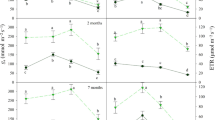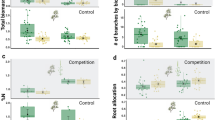Abstract
Juniperus virginiana plants grow faster than other associated tree species in abandoned fields. During the summer the needles of the species do not light saturate even at 1,750 μE m-2 s-1, reach optimum photosynthesis at ∼20°C, and maintain maximum photosynthesis at-8 to-12 bar twig water potential. In the field, the plants experience pronounced daily changes in water potential. The magnitude of the changes becomes more pronounced later in the summer. Leaves of the mature plants have highest rate of photosynthesis, young trees intermediate, and seedlings lowest. In winter there is a slight shift in optimum temperature for photosynthesis and the plants photosynthesize at 0°C. The rates of photosynthesis are lower in winter than in summer. On sunny days with calm winds, mature individuals and seedlings maintain significantly higher temperatures than air temperature while intermediate plants do not. The latter exhibit a lower photosynthetic rate than both mature plants and seedlings. The trends of photosynthesis, in the 3 size classes, both in winter and summer, correspond to the chlorophyll content of their leaves. It is concluded that J. virginiana grows well in open field habitats because it is a sun-adapted, drought resistant species with a long growing season which includes winter. The species is excluded from mature forests because it is shade-intolerant.
Similar content being viewed by others
References
Bacone, J., Bazzaz, F.A., Boggess, W.R.: Correlated photosynthetic responses and habitat factors of two successional tree species. Oecologia (Berl.) 23, 63–74 (1976)
Bazzaz, F.A.: Succession on abandoned fields in the Shawnee Hills, southern Illinois. Ecology 49, 924–936 (1968)
Bazzaz, F.A.: Ecophysiology of Ambrosia artemisiifolia: A successional dominant. Ecology 55, 112–119 (1974)
Bazzaz, F.A., Boyer, J.S.: A compensating method for measuring carbon dioxide exchange, transpiration, and diffusive resistances of plants under controlled environmental conditions. Ecology 53, 343–349 (1972)
Bazzaz, F.A., Mezga, D.M.: Primary productivity and microenvironment in an Ambrosia-dominated field. Amer. Midl. Nat. 90, 70–78 (1973)
Bazzaz, F.A., Paape, V., Boggess, W.R.: Photosynthetic and respiratory rates of Sassafras albidum. For. Sci. 18, 218–222 (1972)
Biggs, W.W., Edison, A.R., Easten, J.D., Brown, K.W., Maranville, J.W., Clegg, M.D.: Photosynthesis light sensor and meter. Ecology 52, 125–131 (1971)
Black, C.C., Chen, T.M., Brown, R.H.: Biochemical basis for plant competition. Weed Sci. 17, 338–344 (1969)
Boggess, W.R.: Weekly diameter growth of shortleaf pine and white oak as related to soil moisture. Proc. Soc. Amer. Foresters 83–89, 47 p. (1956)
Bormann, F.H.: Factors determining the role of loblolly pine and sweetgum in early oldfield succession in the Piedmont of North Carolina. Ecol. Monogr. 23, 339–358 (1953)
Boyer, J.S.: Measurement of water status of plants. Ann. Rev. Plant Physiol. 20, 351–364 (1969)
El-Sharkawy, M.A., Loomis, R.S., Williams, W.A.: Photosynthetic and respiratory exchange of carbon dioxide by leaves of the grain Amaranth. J. app. Ecol. 5, 243–251 (1968)
Fehrenbacher, J.B., Walker, G.O., Wascher, H.L.: Soils of Illinois. Illinois Agric. Expt. Sta. Bull. 728 (1967)
Fowells, H.A.: Silvics of forest trees of the United States. Agricultural Handbook No. 271. U.S.D.A., Washington, D.C. (1965)
Jackson, W.A., Volk, R.J.: Photorespiration. Ann. Rev. Plant Physiol. 31, 383–432 (1970)
Kramer, P.J.: Plant and soil-water relationships, 347 pp. St. Louis: McGraw-Hill 1949
Kramer, P.J., Decker, J.P.: Relation between light intensity and rate of photosynthesis of loblolly pine and certain hardwoods. Plant Physiol. 19, 350–358 (1944)
Kozlowski, T.T.: Light and water in relation to growth and competition of Piedmont forest tree species. Ecol. Monogr. 19, 207–231 (1949)
Larcher, W.: The effect of environmental and physiological variables on the carbon dioxide gas exchange of trees. Photosyn. 3, 167–198 (1969)
Moss, D.N.: The limiting carbon dioxide concentration for photosynthesis. Nature (Lond.) 193, 587 (1962)
Scholander, P.F., Hemmel, H.T., Bradstreet, E.D., Hemmingsen, E.D.: Sap pressure in vascular plants. Science 148, 339–346 (1965)
Author information
Authors and Affiliations
Rights and permissions
About this article
Cite this article
Ormsbee, P., Bazzaz, F.A. & Boggess, W.R. Physiological ecology of Juniperus virginiana in oldfields. Oecologia 23, 75–82 (1976). https://doi.org/10.1007/BF00351216
Received:
Issue Date:
DOI: https://doi.org/10.1007/BF00351216




